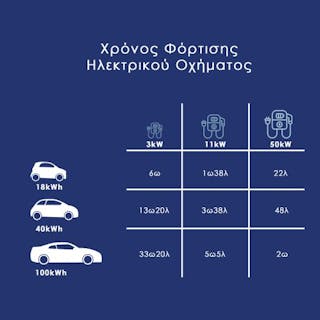
How to choose an electric car charger
How to choose an electric car charger
To choose an electric car charger, you need to take into account your vehicle, the supply on your installation panel and the types of chargers available in the market.
Examine your type of benefit
In Greece, there are the following household electricity supplies:
– Single single phase with general safety 32A – 8 kW
– Reinforced single phase with general safety 50A – 12kW
– Simple three-phase with 3 general fuses 32A – 25kW
– Reinforced three-phase with 3 general fuses 50A – 35kW
Difference between alternating current (AC) and direct current (DC)
The electricity supplied in Greece is alternating (AC), while the electric vehicles operate with direct current (DC). Home car chargers transfer AC power to the electric vehicle and this converts it to direct current through its built-in internal charger. Due to this conversion there are restrictions on charging time and maximum charging power.
The smallest household charger is 7kW, so in single-phase installations, its use, in terms of power, can be marginal. That is, with the simultaneous use of other loads, such as the hob, water heater, etc., the supply may not be resistant to the use of the charger.
Charger selection
Household chargers do not convert AC to DC. This conversion is done by the internal charger of the electric vehicle, with the result that the charging time is longer than a professional charger at a station or gas station.
Most electric vehicles available now have a maximum charging power of 7KW. But as manufacturers continue to improve battery and internal charger technology, it would make sense to install a more powerful charger if you want to replace your electric vehicle with a newer version in the future.
Of course, we remind you to always take into account the power of your installation.
Another parameter to keep in mind is that batteries wear out faster at high AC speeds. Also, many electric vehicle manufacturers program the car’s internal charger to prevent its use below a charge limit, such as when the battery drops to 10%. This is for the safety of the car’s systems.
Charging time of an electric vehicle.

There are 3 types of chargers: with simple socket, with household charger, with professional charger.
Compare 3 different vehicles with different batteries.
Charging time depends on the capacity of the battery and the power of the charger.
SOURCE: Internet